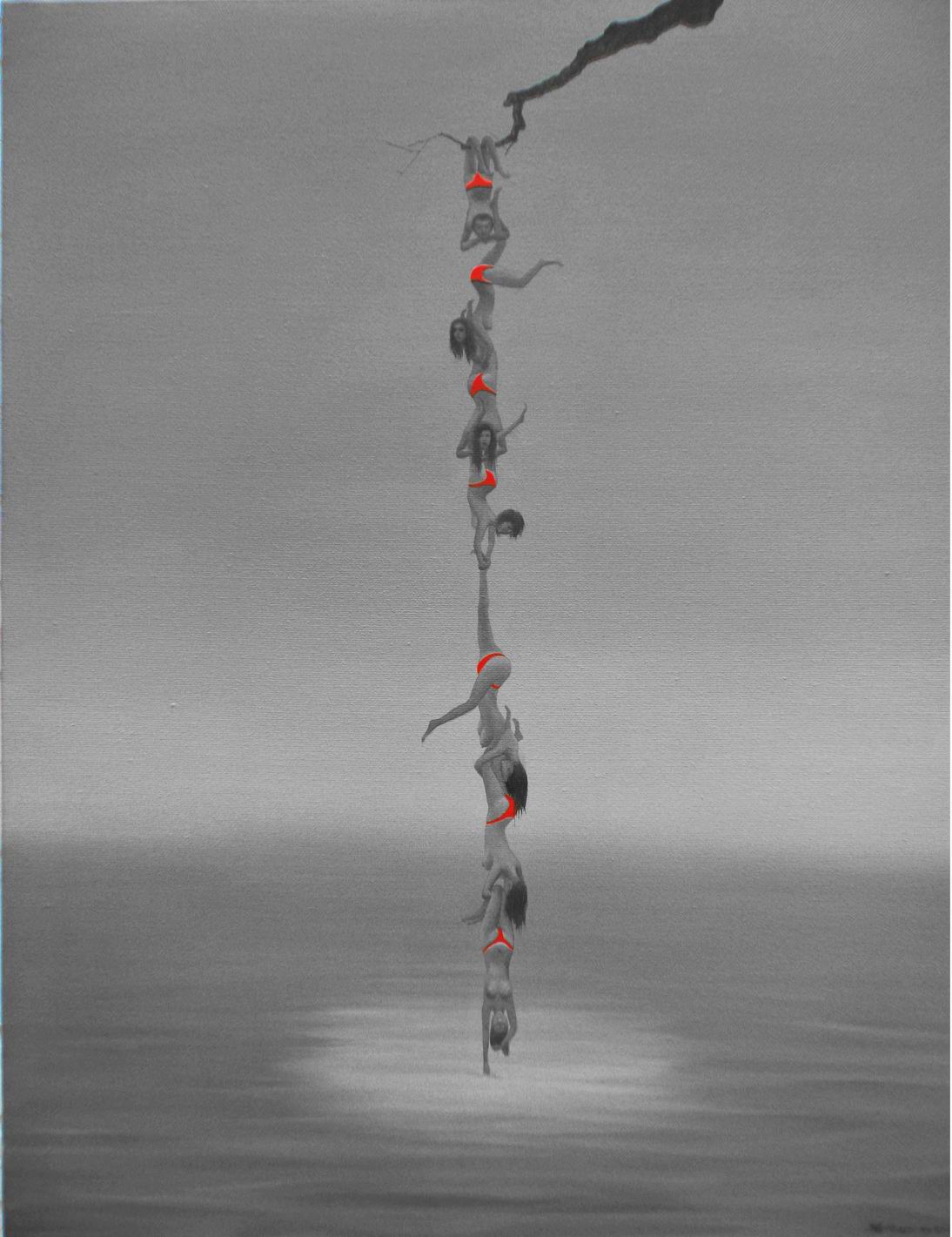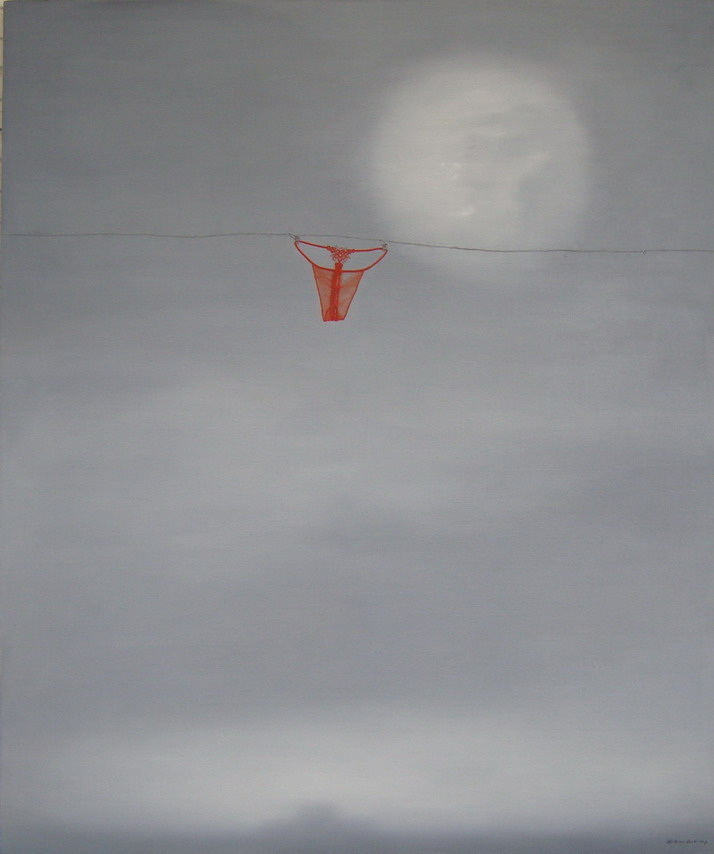Suspended by A Thread
—— Liu Qiming and His Paintings
Gao Ling
No one can say exactly how long a line is, or how much weight it can bear, or how much lightness it can evoke. However, there is an artist who takes the line as the main theme of his creation, interpreting his philosophy of life and art with a single line. This artist is Liu Qiming.
The distance between two physical particles in space is the original meaning of a line, which cannot form a real object. But in Liu Qiming’s art, it plays an important role in connecting heaven and earth and carrying life. Why does a thin and light line have such an important metaphorical significance to him? This is closely related to his personal experience.
Since his middle school years, he seems to have borne pressures that other classmates did not have to face – he was expelled from the Communist Youth League for protesting against cheating in school exams, and he experienced the reality of the June 4th incident through his brother’s military service. For a teenager pursuing progress, idealism was struck by the so-called organizational principles and political reality.
When he just finished university, which had cultivated his naive observation and expression methods of art and reality, the result of his graduation assignment once again shattered his dream of art – he was assigned to teach in the Aba Tibetan-Qiang Autonomous Prefecture Teachers College in Sichuan Province. The religious status of minority areas and the lack of cultural information far from Chengdu made him feel lonely and inconsolable. He was still young and needed art, and needed communication of thought and emotion. So, he established his own studio in Chengdu and shuttled between the Aba Teachers College and the studio on the Chengdu Plain for several years. The exhaustion of time and energy finally led him to resign, because only in this way could he concentrate on painting and realize his artistic dream. However, the reality of life repeatedly made him feel the false and cruel indifference – friends’ urging led him to join a scam; the endless meetings and regulations of the new school made him unable to focus; his mother’s accidental death gave him a painful insight into the harsh reality of urban-rural differences.
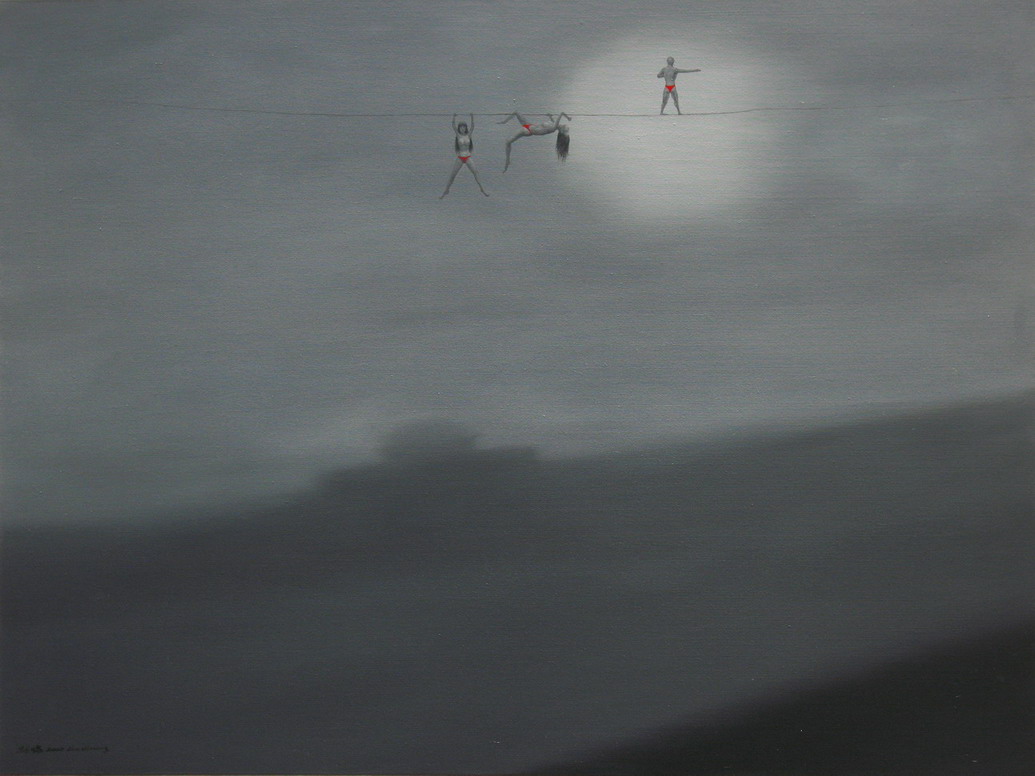
He should have had sufficient time and energy to engage in his favorite painting creation, but in his thirty-odd years of life, he has been tormented by the realities of life. He should have vented his pain in his paintings with vigorous images and found dignity and meaning in life through his art. However, when we see his recent works created in Beijing over the past two years, we feel more elusive calmness and indifference. In the unpredictable and dark sea of clouds, there is a symbol of political power that is faintly visible but never disappears. The tornadoes and mushroom clouds released from there, as the energy field of external political power, can cover the sky, make the sun and moon invisible, and make all things bleak. After experiencing many things, Liu Qiming learned to see the essence through appearances. The external constraints and real-life conflicts could not arouse his interest in expressing with his brush. He wanted to express his answers to these pressures and troubles and stand on a higher point of view to grasp the invisible hand that controls the concrete world of reality. Therefore, he chose a metaphorical approach, combining the layered dark clouds symbolizing the weight of reality with the seemingly small symbolic architectural structure in one painting. One is the vast and boundless natural phenomenon that seems to be nothing, and the other is the artificial thing that contains huge power energy, but the combination of these two things in the painting only makes sense because of the existence and confusion of Chinese people.
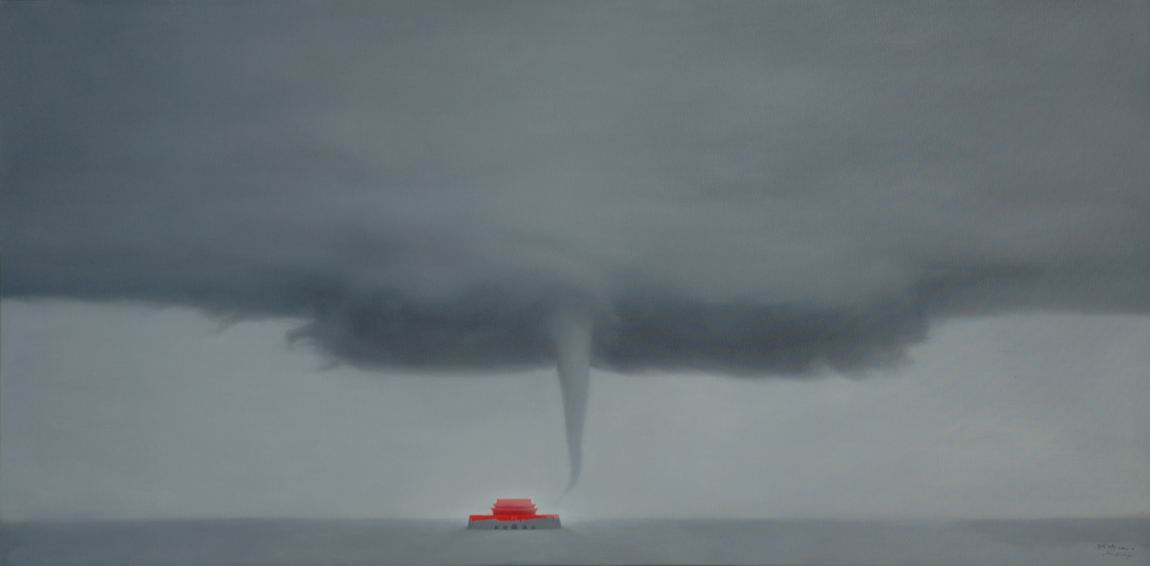
In the foreground of the painting, the suspended figures like dolls are the artist’s ultimate focus. They are naked, leaving only a piece of red cloth to cover their modesty. On this sea of clouds that seems to swallow everything, they do not seem to be panicked but are mechanically repeating some predetermined actions that have been “melted into their blood and implemented in their actions” by external forces. These actions come from the model operas of the Mao Zedong era, which were well known during the so-called “passionate burning years.” However, in Liu Qiming’s eyes today, they are just superficial actions because the illusory ideals of the past have long been gone and no one believes in them anymore. However, the bodies of the characters have been preserved by the artist. Therefore, we can see from the painting that these dancing figures do not have much characterization, and everything is only suggestive and outline.
These mechanical and rigid dramatic characters and the red ropes hanging from above are so mismatched that we can’t help but doubt whether these falling people can be saved by them. In fact, this delicate rope is just a thread of life, unable to bear the weight of so much history and politics. It is symbolic and suggestive, like the red underwear, red scarf, and red flag that appear in some works. They are symbols of the unbearable weight of life and the sigh of the unbearable lightness of being.
The heavy and gloomy background is connected to the light and bizarre foreground by a lifeline, which is compared to the thread of human life. However, it is so delicate that it cannot bear the power and radiance of life. Thus, a strong sense of crisis and unease surges through the picture, floating and ubiquitous, and no one can truly escape its control. This is Liu Qiming’s tragic awareness, and it can at least evoke the audience’s sense of sorrow.
Date: June 10th, 2008
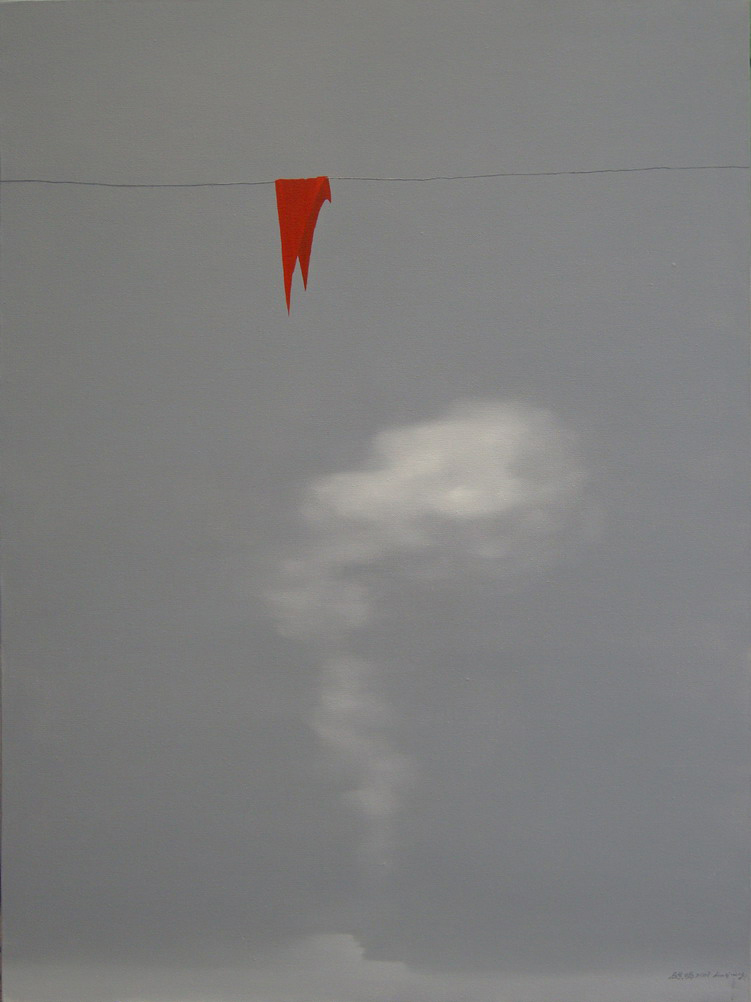
命悬一线
——刘骐鸣其人其画
高 岭
没有人能够说清楚一根线,究竟有多长,究竟能够串联起多少赘重,又能够挑拨出多少轻盈?然而有这么一位艺术家,他却把线作为自己创作的主要题材,用一根线演绎了他的人生观和艺术观,这人便是刘骐鸣。
空间中两个物理颗粒之间的距离连接,便是线的本义,它原本无法构成一个现实之物,但在刘骐鸣的艺术中却扮演了勾连天地、承载人生的重要作用。一根纤细和轻盈的线条,为何他对此竟有如此重要的比附?这与他的本人的经历有着很大的关系。从中学时代起,他好像就开始承受其他同学没有的压力——他因自己对学校考试舞弊的抗议而被开除了团籍;他从参军的哥哥的亲身经历感受到八九风波真实的一面。对于一个十几岁的青少年人来说,追求进步的理想受到来自所谓的组织原则和政治现实双重的打击。而当几年大学刚刚培养起他懵懂的艺术与现实的观察和表现方法的时候,毕业分配的结果再一次打击了他的艺术之梦——他被分到四川阿坝藏族羌族自治州师专教书。少数民族地区的宗教状况和远离省会成都带来的文化信息匮乏,使他的内心充满了孤寂和无慰,他还年轻,他需要艺术,需要思想和情感的交流。于是,他在成都与建立了自己的工作室,接下来的几年时间里,他穿梭在工作岗位的阿坝师专和成都平原的工作室之间,时间和精力的消耗终于使他做出了辞职的决定,因为只有这样,他才能够安心画画,实现自己的艺术梦想。可是,随后的生活现实又一次次地让他感受到虚假和残酷冷漠的一面——朋友的鼓动使他加入到一场骗局之中;新调任学校的文山会海和规章制度令他分身无术;母亲的意外死亡让他对城乡差异的严酷现实有了切肤之痛。
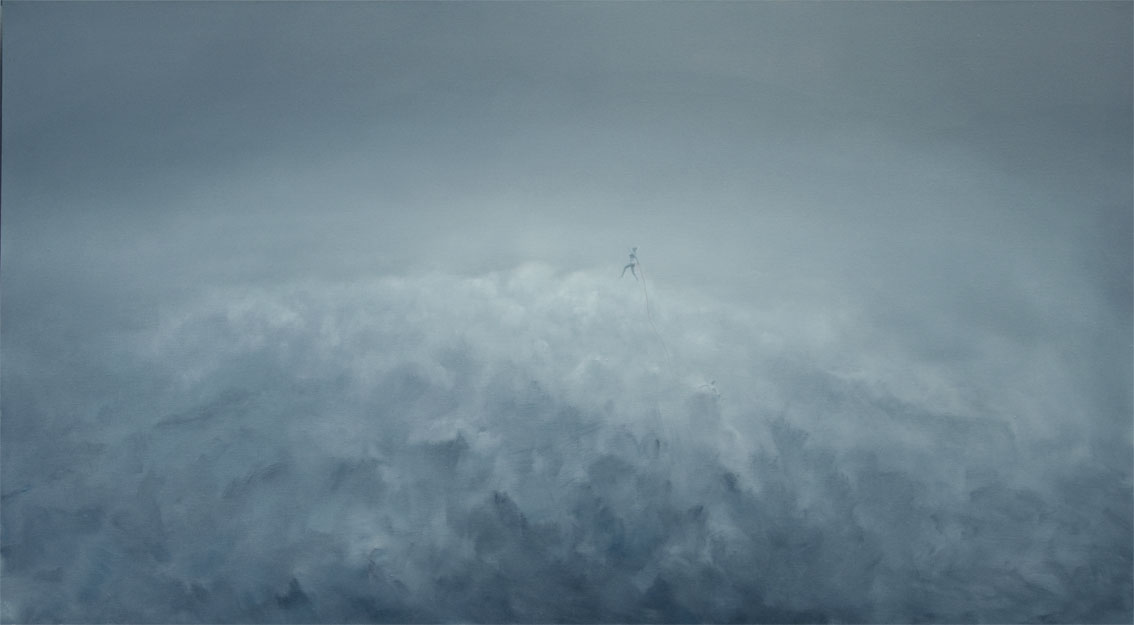
他原本应该有充足的时间和精力从事自己喜爱的绘画创作,但他三十几年的人生时间里,却饱受生活现实的捉弄;他原本应该在自己的画面中以激越的形象将这些苦痛宣泄出来,一吐为快,因为只有在绘画里,他才能找到人的尊严和生活的意义。但是,当我们看到他这两年来北京发展后创作的近作时,却更多地感受到一种难以捉摸的沉静和冷漠。飘忽不定、浓郁黝黑的云海深处,是若隐若现却永远挥之不去的政治权力的象征性建筑一角,从那里释放出的龙卷风和蘑菇云,作为外在政治力量的能量场,可以遮天蔽日,让日月无光,令万物萧条。经历了许多事,刘骐鸣学会了透过现象看本质,外在的约束和现实的纷争困扰,都无法引起他用手中的画笔表现的兴趣,他想要表现自己对这些压力和困扰追问的答案,想让自己站在更高的视点抓住控制现实具体世界的那只看不见的手。于是,他选择了隐喻的手法,将寓意现实之重的千层乌云与那看似渺小些微的象征性建筑符号融合在一个画面之中。一个是看似虚无却浩淼无边的大自然天象,一个是看似无机却蕴藏巨大权力能量的人工之物,这两者在绘画中的结合,只因为中国人的存在,只因为中国人的困惑,舍此,整个画面将显得空泛和乏力。
画面前景中宛若玩偶般悬吊着人物,才是艺术家最终的关注点。他(她)们赤身裸体,只留下一块遮羞的红布,在这个仿佛要吞噬一切的万丈云海之上,他(她)们似乎并没有惊慌失措,而是机械地重复着一些早已被外力“融化到血液中、落实到行动上”的规定性动作。这些动作来自毛泽东时代的样板戏,是那个所谓“激情燃烧岁月”里人们耳熟能详的剧目,可在今天的刘骐鸣眼里,就只剩下徒有其表的动作姿态了,因为斗转星移,当年的那种空幻的理想早已荡然无存,也无人再信,而人物角色的躯壳却被艺术家保留了下来。所以,我们从画面上可以发现,这些舞蹈人物并没有过多性格特征的描绘,一切都只是一种提示性和轮廓性的。
这些机械、僵硬的戏剧性人物与高处悬垂下来的红色绳索是如此地不协调,以致于我们不能不怀疑这根绳索究竟能否拯救这些坠落之人。而事实上,这根纤纤细绳只不过是生命的游丝,它无法承受如此之多的历史和政治的重负。它是象征性的,也是暗示性的,就像有些作品中出现的红内裤、红领巾和红旗,它们是生命不能承受之重的象征,也是生命不能承受之轻的感叹。
背景的厚重阴沉与前景的轻盈怪诞,被一根救命索连接起来,它被比附为人的生命游丝,可它是那样地纤细,何以负载生命的力量和光芒?于是,一种强烈不安的危机意识涌动在画面的上下左右,它飘忽但无处不在,无时不在,没有人能够真正摆脱它的控制。这是刘骐鸣内心的悲剧意识,也至少能够唤起我们观众的忧伤意识。
2008-6-10
